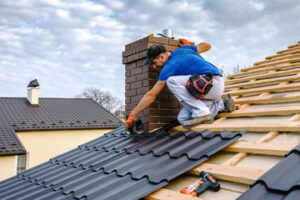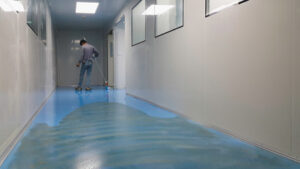Home » Articles posted by Steve Waller
Author Archives: Steve Waller
Steps in the Roofing Installation Process
Whether it’s asphalt or metal, your roof protects your house from the elements. Getting it replaced is a big job. The first step is prepping the area.

Roofing contractors set up tarps to cover anything on your property that could be damaged by debris falling from the roof. They also cover plants and move vehicles out of the way to ensure everyone’s safety.
Once you’ve decided to re-roof, the contractor will prepare your property for installation by bringing in the necessary equipment. They will lay tarps around the bushes, sculptures, and landscaping features to protect them from falling debris during the roof installation process. They will also park a dumpster in your driveway to make it easy to dispose of any old roofing materials. In addition, they may bring a large magnet to sweep the ground and attic to remove any stray nails from the old roofing material or discarded shingles.
Depending on the scope of your re-roofing project, you may need to move any vehicles or outdoor furniture away from the work area. This allows the crew safe movement throughout your property and ensures their vehicles don’t damage your home or belongings. It’s also a good idea to have your children and pets stay at another location during the roof installation process, as the noise from hammers and nail guns can make them anxious or distract them from their normal activities.
If you have wall-hung pictures or delicate mementos, consider taking them down before the roofing crew arrives. Likewise, it’s a good idea to cover any items stored in the attic as the vibrations from the hammers and nail guns can cause them to shake loose. If possible, you should also consider moving expensive furniture out of the way so it doesn’t get covered in dust or debris.
Once your shingle or metal roof is installed, the final element that is often overlooked is flashing. This is a metal material that is placed around chimneys, windows, joints, and other vulnerable areas to keep water from entering your home. A quality roofer will install the flashing with precision so that it doesn’t leave any leaky spots.
Whether you are having a new asphalt shingle or metal roof installed, it’s important to communicate with your contractor and ask any questions you have. They should be able to explain the installation process in detail, discuss any potential disruptions to your routine, and address any other concerns you have.
Materials
Whether you’re building a new home or replacing an existing roof, the choice of roofing material is critical. It can have a major impact on everything from the exterior appearance to longevity and energy efficiency. Before you choose a material, consider the climate in your area and any special installation or maintenance requirements that may come with it. Ultimately, the right material can add both value and curb appeal to your property while offering superior protection from the elements.
The foundation of any roof is the framing, which consists of rafters or trusses. Rafters are cut on-site from lumber such as 2x10s, while trusses are prefabricated in a factory and craned into place. On top of the framing, a layer of sheathing is installed. This is typically plywood or oriented strand board (OSB), although older houses may have tongue-and-groove sheathing made of sawn lumber.
There are a variety of roofing materials available for your home, from traditional asphalt shingles to clay tiles and slate roofs. The most common roofing material, asphalt shingles, are a cost-effective option that comes in a range of colors and styles to complement any architectural style. These shingles are durable and weather resistant, with a lifespan of 15 to 30 years or more.
Slate, one of the oldest roofing materials, is fireproof and naturally weatherproof, with a lifespan of 50 to 100 years or more for soft slate and up to 200 years for hard slate. They are expensive, however, and require specialized framing during installation to support their weight.
Rolled roofing material is another affordable option that offers fast installation for low-slope roofs, such as those found on sheds and garages. It is available in a wide range of colors and patterns, with a finished look that can be accented by using metal flashing around penetrations and open valleys. Many shingle manufacturers recommend installing an underlayment, usually a #15 asphalt-impregnated builder’s felt or tarpaper. Synthetic underlayments, such as woven polyethylene, are tougher and less likely to tear during installation, and they resist moisture and air infiltration. They also offer additional waterproofing for vulnerable areas such as eaves, valleys and around penetrations.
Installation
After getting the go ahead from you, your roofing contractor will get set up to begin the process. Depending on the size of your roof, this could take a few hours. They will cover sensitive areas of your property with tarps, have a dumpster delivered, and set up wooden boards to cover anything around the base of your home like plants or the air conditioning unit. They will also cover any open drains to keep small pieces of debris from getting in and blocking them.
If you are re-roofing, your roofer will talk with you about the different options for the new roofing materials. You can choose from dimensional shingles for a beautiful look, three-tab shingles to save money, wood shakes for a natural appearance, metal sheeting for easy maintenance, and clay tiles for extreme durability. You can also add new vents for increased attic ventilation to improve energy efficiency.
Final Inspection
The final inspection is the last step in the roofing installation process. It is the last chance for the contractor to make sure everything was done correctly and is code compliant. During this inspection, the inspector will walk the roof, validate the nailing pattern, look at the flashing in the areas needed, and overall ensure the work was complete to minimum code. If re-roofing is being performed, the inspector will also need to walk the deck and verify that the proper underlayment and/or roof cover was applied and that all areas were covered. Affidavits will be required for re-roofing projects, as the inspector will need to see evidence that the project was completed with correct materials.
The inspection requirements will vary, but the best way to prepare for a final inspection is to have extensive documentation of the project. This includes the obvious, like building plans and proof of passing previous inspections, but it should also include photo records of any changes or revisions made throughout the construction phase. Having this documentation can help the inspector understand the reasoning behind any decisions or issues that may arise. It can also save a lot of time and frustration during the inspection if it is clear that the contractor has the documents to back up their actions.
Many inspectors will provide a checklist prior to the inspection to give contractors an idea of the key items that they should focus on. This can be helpful, but it is important to remember that the key issues will depend on the specifics of the job. For example, minor issues that do not pose a safety risk may be able to be addressed with a quick change or revision, while serious problems will need to be corrected and resubmitted for approval.
It is vital to hire a professional roofer to inspect your new roof and to ensure that it was installed properly. The inspection will uncover any small mistakes that could become big, expensive problems down the road. Skipping the final inspection can also lead to a delay in getting things up to code and obtaining the necessary permit, which can result in costly fines down the line.
Learning the Basics of Poker
When learning poker, it is important to only gamble what you can afford to lose. This will prevent you from getting discouraged by big losses and give you the confidence to keep playing.

Beginners should focus on preflop and flop strategies first. They should also work on position since this will give them more information than their opponents. Find out more about Lezioni Di Poker as you continue through the article.
When you’re playing poker, you must be aware of the rules of the game. While this doesn’t mean that you should memorize complicated systems, it is important to understand the basic rules of poker so that you can make quick decisions and avoid losing your money. For example, it’s important to know the strength of your hand and how to read your opponents’ body language. In addition, you should manage your bankroll and bet responsibly. It’s also a good idea to observe experienced players to learn how they play the game and see how they react to certain situations.
The basics of poker are simple: Each player is dealt two cards that they keep face down, referred to as their hole cards. They can then place bets on their own hand and bluff about the strength of their cards to confuse other players and maximize their chances of winning the pot. Once all of the betting has taken place, the winner takes all of the chips in the pot. If you lose your chips, don’t try to win them back immediately; this can lead to more losses and stress.
Variations
There are a number of poker variants, each with its own rules and strategy. Although they all share the underlying principle of beating your opponent with a better hand, each variant has its own unique set of rules and requires different strategies to win. Some poker variants are not as well-known as Texas Hold’em, but they can be a great way to add variety to your home game.
In the case of Badugi, for example, you must understand how to rank your cards in order to make a winning hand. It also differs from other poker games in that it doesn’t have a common community card. This means that you won’t be able to cross-over your skills from another poker variant as easily.
If you are looking for a more relaxed game, try fixed limit hold’em. This game is safer than pot limit or no-limit, as you can only bet a certain amount per round. In addition, fixed limit hold’em emphasizes value betting, which we will cover in a later lesson.
While Texas Hold’em is still the dominant poker game, it wasn’t always so. There was a time when Stud and Draw poker were far more popular. If you are interested in trying out these other types of poker, this course will teach you the basics of each. Then, you can decide which one suits your style best. Eventually, you may even become a pro in one of these other poker variants. Just be sure to practice often. It will take time and effort to perfect your game.
Betting intervals
Betting is a crucial part of the game, and minimizing losses when holding poor hands while maximizing wins with good ones is what it’s all about. Each betting interval starts with a player making a bet, and each player to his left must either call the bet (putting in enough chips into the pot to match the amount put in by the person before him) or raise it. The raising must be by a certain number of chips, which usually varies depending on the poker variant being played.
In some poker variants, players may choose to check, which allows them to stay in the game without putting any money into the pot. However, a player cannot raise his own bet when checking. Each betting interval ends when all the players have either called or raised each other’s bets or have dropped. The best hand wins the pot. In no limit or pot limit poker, the betting can escalate quickly, which can lead to a fast-paced and exciting game. Fixed limit poker is safer, and the amounts that can be bet are limited.
Bluffing
Bluffing is an important element of poker, but it requires a lot of practice and skill. It is not always profitable, but it can increase your chances of winning a pot if you get it right. To succeed, you need to understand your opponent’s tendencies and patterns, and make sure that your bluffs match their betting patterns. In addition, you need to take your table image into consideration. If you are perceived as a tight player, your bluffs will be more likely to be believed. If you are seen as a wild player, your bluffs will probably fail.
The goal of a bluff is to convince your opponents that you have a strong hand, even though you actually don’t. This can be done by raising the amount of your bet or by betting with a weak hand. Semi-bluffs, which involve a weaker hand that can improve, are also effective, but they require more knowledge of the board than pure bluffs.
It is essential to recognize your opponents’ habits and their reactions after they have called a bluff. Some players may go on tilt after being caught by a bluff, and they will continue to play recklessly in subsequent hands. Others will tighten up in an attempt to preserve their losses. In either case, it is crucial to learn from your mistakes and adjust your strategy accordingly.
Lastly, you should consider the timing of your bluffs. The best time to bluff is when your opponents are distracted and not paying attention to the board or to you. In addition, you should avoid bluffing when you are low on chips. It is much more profitable to play a stronger hand and build your stack.
It is important to pick the right opponents to bluff against. Ideally, your bluff should only work against one opponent. It is not possible to bluff successfully against an entire table, so be selective when making your decisions. The last thing you want is to bluff against a player who calls every bet and never folds, since this will make it nearly impossible for you to win.
